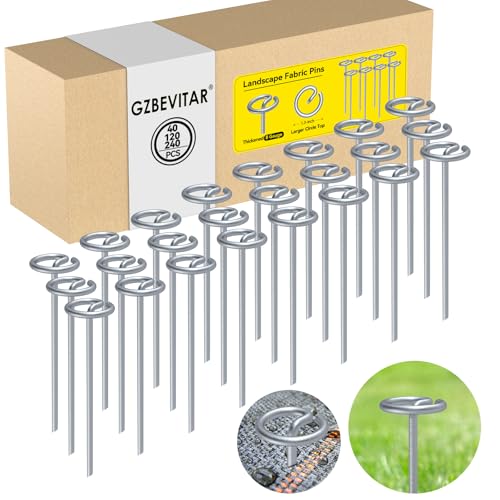If you’re planning a landscaping project, you may be wondering how much landscaping fabric you need. Landscaping fabric, also known as weed barrier fabric, is a permeable membrane that prevents weeds from growing while allowing water and nutrients to penetrate the soil. It’s an essential tool for any gardener or landscaper looking to maintain a healthy and beautiful outdoor space.

The amount of landscaping fabric you need will depend on several factors, including the size of your project, the type of soil you have, and the specific goals you have for your outdoor space. Calculating the right amount of fabric can be a bit tricky, but with a little planning and preparation, you can ensure that you have enough to get the job done right. In this article, we’ll take a closer look at how much landscaping fabric you need and provide some tips and tricks to help you get started.
Key Takeaways
- Understanding the size and scope of your project is the first step in determining how much landscaping fabric you need.
- Planning and preparation are essential for ensuring that you have enough fabric to complete your project.
- Proper maintenance and care can help extend the life of your landscaping fabric and keep your outdoor space looking beautiful for years to come.
Understanding Landscaping Fabric


If you’re planning to do some landscaping work, you might be wondering if you need to use landscaping fabric and how much you’ll need. Landscaping fabric, also known as weed barrier fabric, is a material that is used to control weeds and improve soil health. It’s a popular choice among gardeners and landscapers, but before you decide to use it, it’s important to understand the different types of landscaping fabric, their benefits, and their potential drawbacks.
Types of Landscape Fabric
There are two main types of landscaping fabric: woven and non-woven. Woven fabric is made from polypropylene or polyester and is more durable than non-woven fabric. It’s a good choice for areas with heavy foot traffic or exposure to harsh weather conditions. Non-woven fabric, on the other hand, is made from linen or polyester and is less durable than woven fabric. It’s a good choice for areas with light foot traffic or where you don’t need as much weed control.
Benefits of Using Landscape Fabric
Using landscaping fabric has several benefits. First, it helps control weeds by preventing weed seeds from germinating. This can save you time and effort in the long run since you won’t have to spend as much time weeding. Second, it helps retain moisture in the soil, which can be especially beneficial in areas with drought conditions. Third, it can help improve soil health by preventing erosion and promoting the growth of organic matter and earthworms.
Potential Drawbacks
While there are many benefits to using landscaping fabric, there are also some potential drawbacks to consider. First, it can be expensive, especially if you need to cover a large area. Second, it can make it difficult to plant new plants since you’ll need to cut holes in the fabric. Third, it can prevent nutrients from reaching the soil, which can be detrimental to plant growth. Finally, it can be difficult to remove once it’s been installed, which can be a problem if you decide to change your landscaping in the future.
Overall, landscaping fabric can be a great choice for controlling weeds and improving soil health. However, it’s important to understand the different types of fabric, their benefits, and their potential drawbacks before you decide to use it.
Planning Your Landscaping Project

Before starting any landscaping project, it’s important to plan out the details to ensure a successful outcome. This includes assessing the area, choosing the right fabric, and determining the quantity needed.
Assessing the Area
The first step in planning your landscaping project is to assess the area. Use a tape measure to determine the square footage of the area you want to cover. If you prefer metric measurements, measure the area in square meters. Take note of any dips, hills, or slopes in the area, as these will affect the amount of fabric needed.
Choosing the Right Fabric
There are two main types of landscaping fabric: woven and non-woven. Woven fabric is stronger and more durable, while non-woven fabric is more permeable and lighter in weight. Consider the needs of your project when choosing the right fabric. If you have heavy foot traffic or want to prevent weeds from growing, woven fabric is the better option. If you’re looking for a more permeable option, non-woven fabric is a good choice.
It’s also important to choose a fabric with UV protection to prevent it from breaking down over time. Look for a fabric with a weight of at least 3-6 mils for optimal durability.
Determining Quantity Needed
To determine the quantity of fabric needed for your project, calculate the area of the project and the width of the fabric roll. Most rolls of landscaping fabric are 3-6 feet wide and come in lengths of 50-300 feet. To ensure proper coverage, overlap the fabric by at least 6 inches.
To calculate the amount of fabric needed, divide the area of the project by the width of the fabric roll. For example, if your project is 100 square feet and the fabric roll is 3 feet wide, you will need approximately 34 linear feet of fabric (100/3 = 33.33).
By following these simple steps, you can accurately determine the amount of landscaping fabric needed for your project.
Preparation and Installation

Before you start installing the landscaping fabric, it’s important to prepare the soil properly. This will ensure that the fabric is installed correctly and will provide the best results.
Preparing the Soil
Start by removing any weeds or grass from the area where you plan to install the landscaping fabric. This will prevent them from growing through the fabric and causing problems later on. You can use a hoe or a garden rake to remove the weeds and grass.
Next, you should consider adding organic matter to the soil. This will improve the soil structure and provide nutrients for your plants. You can use compost, well-rotted manure, or other organic materials to achieve this.
Laying the Landscape Fabric
Once the soil is prepared, you can start laying the landscaping fabric. Measure the area where you plan to install the fabric and cut the fabric to size. Make sure to leave some overlap at the edges to ensure that the fabric covers the entire area.
Lay the fabric over the soil, making sure that it’s flat and smooth. You can use landscape staples or pins to secure the fabric to the ground. Be sure to place the staples or pins at regular intervals to prevent the fabric from shifting or moving.
« Landscaping Options Instead of Grass: A Friendly Guide to Low-Maintenance Alternatives Best Way to Landscape a Hill: Tips and Tricks for a Beautiful Yard »
Securing and Protecting the Fabric
To protect the fabric from erosion and other damage, you can cover it with inorganic mulch, such as rocks or gravel. This will also help to prevent weeds from growing through the fabric.
If you prefer to use organic mulches, such as wood chips or bark, you can place them on top of the fabric. However, keep in mind that organic mulches will break down over time and will need to be replaced periodically.
By following these steps, you can ensure that your landscaping fabric is installed correctly and will provide the best results. Remember to take your time and be patient during the installation process, and you’ll be rewarded with a beautiful and healthy garden.
Maintenance and Care

When it comes to maintaining your landscape fabric, there are a few things to keep in mind. Proper maintenance can help ensure the longevity of your fabric and keep your garden looking its best.
Managing Weeds and Growth
One of the primary benefits of landscape fabric is its ability to control weed growth. However, it’s essential to monitor your garden regularly to ensure that weeds aren’t sprouting or reseeding on top of the fabric. If you do notice weeds, pull them out by hand or use an herbicide that won’t harm your plants.
Soil and Plant Health
Landscape fabric can help retain moisture and nutrients in the soil, which can be beneficial for plant health. However, it’s essential to ensure that your plants are receiving enough water and nutrients. Consider adding organic materials or amendments to the soil to help improve its quality.
Fabric Longevity
To ensure that your landscape fabric lasts as long as possible, avoid walking on it or placing heavy objects on top of it. Over time, the fabric can break down and become less effective at controlling weeds and retaining moisture. Additionally, be sure to monitor the fabric for signs of damage from fungi or insects.
Overall, proper maintenance and care of your landscape fabric can help ensure that your garden stays healthy and beautiful. By monitoring weed growth, ensuring proper soil and plant health, and protecting the fabric from damage, you can enjoy the benefits of landscape fabric for years to come.
Additional Landscaping Elements

When planning your landscaping project, it’s important to consider all the elements that will be involved. In addition to the landscaping fabric, there are several other elements that will be important to consider.
Incorporating Mulch and Rocks
Mulch and rocks can be a great addition to any landscaping project. They can help to retain moisture in the soil, prevent weeds from growing, and add a decorative touch to your garden. When using mulch or rocks, it’s important to consider the type of material that you will be using. Organic mulch, such as wood chips or shredded leaves, will break down over time and can help to enrich the soil. Inorganic mulch, such as rubber or plastic, will not break down and can be a more permanent solution. Rocks can also be used in place of mulch and come in a variety of sizes and colors.
Working with Trees and Larger Plants
Trees and larger plants can be a great addition to any landscaping project, but they can also require more planning. When working with trees and larger plants, it’s important to consider their size and growth patterns. You will need to ensure that they have enough space to grow and that they will not interfere with any other elements of your landscaping project. You may also need to consider the type of soil that they require and any additional watering or maintenance that they may need.
Hardscaping and Decorative Touches
In addition to landscaping fabric, mulch, rocks, and plants, there are several other elements that can be used to add a decorative touch to your landscaping project. Hardscaping elements, such as stones or pavers, can be used to create walkways or patios. Decorative touches, such as statues or fountains, can also be added to create a unique and inviting space. When incorporating hardscaping or decorative touches, it’s important to consider the environment and ensure that they will be able to withstand the elements.
Estimating Costs and Purchasing

Landscaping fabric is a great way to keep weeds at bay and ensure your garden looks neat and tidy. But how much do you need? And how much will it cost? In this section, we’ll answer those questions and more.
Calculating Material Costs
The cost of landscaping fabric can vary depending on the size of your project and the quality of the material you choose. To estimate the cost of your project, you’ll need to know the size of the area you want to cover. Measure the length and width of the area and multiply the two numbers together to get the square footage. Then, divide the square footage by the square footage of a roll of landscaping fabric to determine how many rolls you need to purchase.
Choosing a Landscaping Service
If you’re not comfortable installing the landscaping fabric yourself, you may want to hire a landscaping service to do the job for you. When choosing a service, be sure to get quotes from several different companies and compare their prices and services. Look for a company that has experience installing landscaping fabric and that offers a warranty on their work.
DIY vs. Professional Installation
Installing landscaping fabric yourself can save you money, but it can also be time-consuming and require a lot of physical labor. If you decide to go the DIY route, be sure to read the manufacturer’s instructions carefully and follow them closely. You’ll also need to purchase the necessary tools and materials, such as landscaping fabric, stakes, and a utility knife.
If you hire a professional to install the landscaping fabric for you, they will take care of all the hard work and ensure that the job is done correctly. However, this option will be more expensive than doing it yourself. Consider your budget and your available time when deciding which option is right for you.
When purchasing landscaping fabric, you can find it at your local garden center or home improvement store. Be sure to compare prices and quality before making a purchase. Look for a durable weed barrier that will last for several years and that is easy to install.
Frequently Asked Questions

What’s the best way to calculate the amount of landscape fabric required for a garden project?
To calculate the amount of landscape fabric needed for your garden project, measure the length and width of the area you want to cover. Multiply the length and width together to get the total square footage. Then, add 10% to the total square footage to account for overlap and trimming. This will give you the total square footage of landscape fabric needed for your project.
Can you suggest the optimal overlap amount for landscape fabric to prevent weeds?
The optimal overlap amount for landscape fabric to prevent weeds is 6-12 inches. This will ensure that there are no gaps in the fabric where weeds can grow through. Overlapping the landscape fabric also helps to prevent the fabric from shifting or moving over time.
How many staples are typically needed to secure landscape fabric effectively?
The number of staples needed to secure landscape fabric effectively depends on the size of your project. As a general rule of thumb, use one staple every 3-4 feet along the edges of the fabric and one staple every 1-2 feet in the center of the fabric. This will ensure that the landscape fabric stays in place and does not shift.
What type of landscape fabric is most durable for use with gravel areas?
For use with gravel areas, a heavy-duty woven landscape fabric is the most durable option. Woven landscape fabric is strong and can withstand the weight of the gravel without tearing or ripping. It also allows for good water drainage, which is important in areas with heavy rainfall.
What are the advantages of woven over non-woven landscape fabric for different landscaping tasks?
Woven landscape fabric is more durable than non-woven landscape fabric and can withstand heavy foot traffic and exposure to harsh weather conditions. It is also more effective at preventing weed growth, as it is thicker and provides better coverage. Non-woven landscape fabric is lighter and more flexible, making it easier to install and work with.
Is gray landscape fabric better than other colors, and if so, why?
Gray landscape fabric is not necessarily better than other colors. The color of the landscape fabric does not affect its performance. However, some people prefer gray landscape fabric because it blends in better with the surrounding environment and is less noticeable.
















